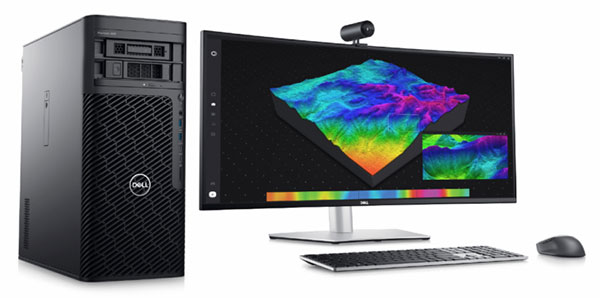Choosing the Right Computing Options for Enhanced Workflows
Getting the ideal hardware for your engineering applications isn’t just about the price tag.

Dell Precision 7865 Tower uses an AMD Ryzen Threadripper PRO processor, a first for Dell. The system is designed for mixed-use workflows in engineering, architecture, data science, VR/AR and other demanding applications. Image courtesy of Dell.
Engineering Computing News
Engineering Computing Resources


AMD

Dell

Lenovo

Latest News
August 15, 2023
Engineering workflows are increasingly complex and demanding. How do engineering teams pursue selecting the most suitable computing infrastructure? Like a multiple choice quiz question, options range from investing in more powerful workstations to deploying high-performance computing (HPC) clusters, expanding data center capacity or adopting cloud-based solutions—or all of the above.
Understanding Workflow Needs
When evaluating computing options, it is crucial to understand specific requirements of software applications and the data they create. Armando Acosta, HPC product management director at Dell, emphasizes the importance of comprehending the software used and the nature of tasks performed. This includes factors such as dataset size, computational demands and the potential for scalability.
“If a customer has a cluster today, we want to understand what code they are using, whether it be Fluent, Ansys, Siemens or others,” says Acosta. “Then we want to balance licensing costs with storage and compute costs.” For example, if the customer goes with a 128-core AMD processor, licensing costs might go up three or four times compared to their existing Intel-based processing, which has fewer cores. “It is essential to take into consideration datasets and job times to get the biggest bang for [the] buck.”
Acosta also notes that AMD-based servers are gaining traction in HPC. “There is loyalty [to Intel], but there is also a best performance issue going forward.”
Evaluating Current and Future Requirements
To make informed decisions, companies must evaluate their current computing requirements and anticipate future needs. This evaluation involves assessing the software applications in use, identifying hardware bottlenecks and considering the anticipated changes required for improved performance.
Scott Hamilton, industry strategist for engineering and manufacturing at Dell, suggests hardware requirements should be tailored to meet the diverse needs of individual users and teams, while also considering future growth projections.
“Engineering teams should look beyond budget constraints and instead focus on the overall productivity gains and time-to-market improvements that can be achieved by investing in the right computing infrastructure.”
Hamilton says the initial conversation with a new customer generally “starts with an opening statement of ‘I need new workstations and my budget is X.’”
Hamilton says that is not the right first question. “Think of the big picture. Engineers are highly paid, skilled employees. How do you buy the best workstation to increase productivity?”
The cost of the employee is much more than the cost of a workstation, Hamilton says. A company’s finance department will say the return on investment (ROI) in this situation represents the fully loaded cost of employees divided by the cost of the investment. Hamilton offers a simplified example.
“$100,000 is the fully loaded employee cost,” Hamilton says. “If I can sell them a workstation that makes each engineer 10% more productive, they are saving $10,000. The math of workstation price becomes insignificant in the ROI.”
Dell notes that AMD is a stronger player in the workstation market compared to years past. The Dell Precision 7865 was released in 2022 using the Threadripper Pro CPU. “Demand is growing; customers are happy with Threadrippers,” says Hamilton.
Acosta says a similar rethink is necessary when considering HPC or cloud computing options. At the recent Supercomputing Conference, Dell demonstrated 100,000 simulations. “We did it on-premises, because it is too expensive to go to the cloud,” Acosta says. “If you use cloud computing once every 60 days that’s OK, but daily? You definitely want on-premises. The user has more control. There is no moving data back and forth—everything is done inside your four walls.”
Investing in more powerful workstations offers numerous advantages, including enhanced workflow efficiency, faster time to market, access to advanced software features and increased productivity. Additionally, newer workstations are more power-efficient, reducing the organization’s carbon footprint. However, limitations can arise if workstations are not configured correctly or if workflows require more scalable solutions, such as HPC clusters.
Comparing HPC Clusters With Cloud
In-house HPC clusters are well-suited for certain engineering workloads, but their implementation should be driven by a deep understanding of the software applications, computational requirements and licensing costs associated with the workload. Proper optimization and balancing of HPC clusters with workstations can help reduce overall costs and ensure efficient use of compute resources.
Scalability is a crucial factor in determining whether to expand data center capacity or adopt cloud-based solutions. The decision depends on factors such as the size of datasets, the need for real-time data analysis, mobility requirements and ongoing costs.
The leading hardware vendors all offer services for running these larger installations. One example is the “as-a-service” solution Lenovo TruScale, which the company says manages scalability balanced with predictable and manageable operating expenses. This allows a more efficient shift of capital expenses to predictable and scalable operating expenses. This allows companies to optimize their budgets, manage cash flow and ensure cost-effective use of computing resources.

LenovoTruScale offers HPC as a service. HPC cluster resources and controls have shared access through a pay-per use model managed and supported by Lenovo. Image courtesy of Lenovo.
Cloud-based solutions offer advantages such as flexibility, faster access to new technologies, enhanced security measures and improved collaboration. However, challenges related to data ingest and extraction costs, limited end-user performance and data throughput limitations need to be considered. Organizations must carefully evaluate their specific needs and weigh the benefits against the potential limitations before adopting cloud-based solutions.
Cloud-based solutions employ various security measures to protect data at rest and in motion. These measures include secure architecture, compliance enforcement, due diligence, network monitoring and robust authentication protocols. Continual advancements in cloud security and compliance methodologies provide peace of mind and ensure data protection for engineering projects.
Future Proofing Computing Infrastructure
To future proof their computing infrastructure and ensure compatibility with evolving engineering workflows and technologies, companies must consider multiple factors. Understanding software application usage and roadmaps helps anticipate future requirements. It is also essential to choose a scalable computing solution that can adapt to changing needs. For some, investing in as-a-service models can provide access to the latest technologies and a flexible approach to resource allocation.
Choosing the right computing option(s) for engineering workflows is a critical decision that impacts productivity, efficiency and business outcomes. By evaluating current and future computing requirements, understanding the advantages and limitations of each option, considering scalability and cost implications, and embracing technologies like cloud-based solutions, organizations can optimize their computing infrastructure. Successful integration of different computing options, as demonstrated by industry case studies, further emphasizes the importance of tailoring solutions to meet specific workflow needs. With the right approach, companies can unlock enhanced performance and improved collaboration, and future-proof their engineering computing infrastructure.
More AMD Coverage

More Dell Coverage

More Lenovo Coverage

Subscribe to our FREE magazine, FREE email newsletters or both!
Latest News
About the Author
Randall S. Newton is principal analyst at Consilia Vektor, covering engineering technology. He has been part of the computer graphics industry in a variety of roles since 1985.
Follow DE



